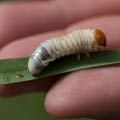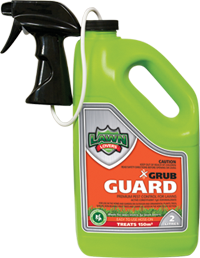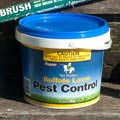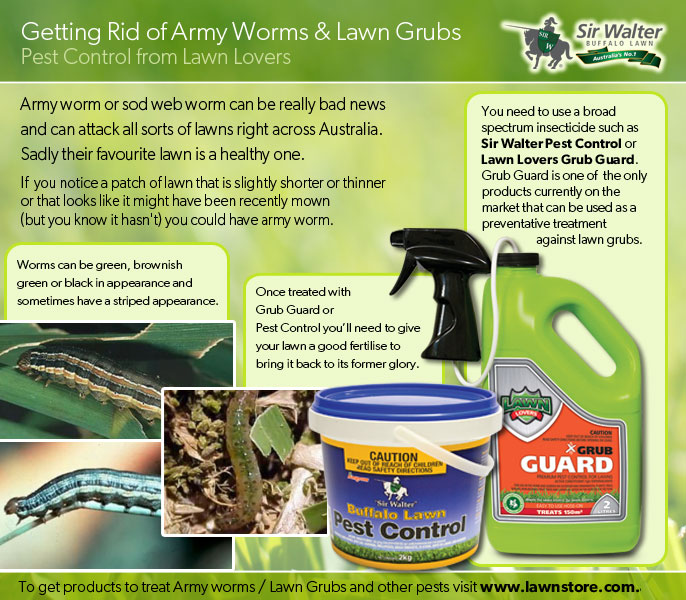 If you find your lawn afflicted with the curse of the lawn grubs don’t despair. Treating and eradicating these pests is relatively easy. Lawn grubs can also be known as army worms or sod web worms and despite their name they all can cause a lot of damage to your turf in a relatively short amount of time, in fact, lawn grubs can feed on 30cms of lawn each and every night.You will need to be particularly vigilant as the weather warms up, usually September to March, and after heavy rain. Couch and Kikuyu varieties are usually the most prone to attack and Buffalo to a lesser extent. Once you have determined that you are indeed under attack you must defend your lawn without delay.
If you find your lawn afflicted with the curse of the lawn grubs don’t despair. Treating and eradicating these pests is relatively easy. Lawn grubs can also be known as army worms or sod web worms and despite their name they all can cause a lot of damage to your turf in a relatively short amount of time, in fact, lawn grubs can feed on 30cms of lawn each and every night.You will need to be particularly vigilant as the weather warms up, usually September to March, and after heavy rain. Couch and Kikuyu varieties are usually the most prone to attack and Buffalo to a lesser extent. Once you have determined that you are indeed under attack you must defend your lawn without delay.
Due to the rate at which lawn grubs feed (and move across your lawn), the amount of eggs they lay and the sheer numbers involved in an infestation delaying treatment can be disastrous.
Your local turf farmer, online lawn care product provider or nursery can supply advice and a fast acting insecticide such as Lawn Lovers Grub Guard or Sir Walter Pest Control to get  the job sorted quickly and easily. Always follow the manufacturer’s handling and safety instructions and use a product that is designed especially for the type of lawn you have. Each different insecticide product type requires a different method of application so it is essential that you read all instructions to receive the outcome you need; no more lawn grubs.
the job sorted quickly and easily. Always follow the manufacturer’s handling and safety instructions and use a product that is designed especially for the type of lawn you have. Each different insecticide product type requires a different method of application so it is essential that you read all instructions to receive the outcome you need; no more lawn grubs.
Because lawn grubs bury themselves in the soil during the day and come out to feed at night the most effective time to apply the treatment is as late in the day as possible while the adults are active. If you are treating during a dry spell remember to water the insecticide into the lawn. If you are lucky enough to have rain coming then use the opportunity to your advantage; apply the treatment while the rain is falling.
To ensure that the grubs are completely eradicated, apply the treatment again in two weeks. This is an especially important timeframe considering that the lawn grub’s lifecycle is 2 weeks long. A re-application at this point will ensure that any missed moths, eggs or grubs are eliminated.
Unfortunately attack by lawn grubs can happen to any lawn and can occur numerous times during a season. Changing the active ingredient in the insecticide used from season to season can ensure that there is no resistance to the treatment process.
Keep an eye out for the moths and red coloured wasps with a long sting that hover above the lawn when grubs are present (the moths are the adult of the lawn grub and the wasp their predator), higher than usual amount of birds (particularly ibis, plovers and magpies) flocking to and feeding from your lawn and white or yellow cocoons on nearby fences, trees and under eaves. If any of these signs are present then chances are that the lawn grubs are back. Treat immediately.
 You might also like to keep one eye on your neighbour’s lawn too. An infestation on their property can very swiftly move beyond their fence line and into your yard.
You might also like to keep one eye on your neighbour’s lawn too. An infestation on their property can very swiftly move beyond their fence line and into your yard.
Lawn grubs are very fond of the new shoots that newly laid turf provides. While you are already tending to your new lawn by watering to aid establishment watch for attack. Lawn grub moths can travel up to 5kms to lay eggs in your new additional to your home and lifestyle.
While the lawn may look beyond repair after a lawn grub attack, the roots of the turf are largely unharmed; an application of fast acting fertiliser will get your lawn a boost for quick regrowth.




